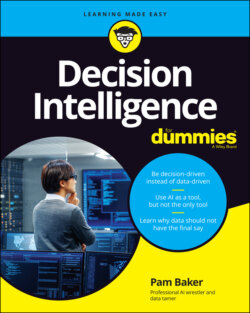Читать книгу Decision Intelligence For Dummies - Pamela Baker - Страница 47
Machines Make Human Mistakes, Too
ОглавлениеPeople commonly believe that machines are unbiased and more perfect than humans. Data analytics, automation, and machine learning (referred to as AI by marketers everywhere) are often presented as though the machines are capable of sorting out the data and reaching a perfect and fair conclusion on their own.
This simply isn’t true. It’s imperfect humans — not perfect machines — who make the technologies, set the rules, design the models, and select the training data. That means subconscious or intentional human influence can seep into every step: the rules, the programming and models, and the data selection. In short, the creation mirrors the creator. Machines are influenced by humans who build them and therefore frequently make many of the same mistakes humans make. Examples are numerous and varied. They include institutional biases, such as the (infamous) example of the continued use of redlining, a discriminatory practice in bank lending and other financial services that draws a figurative redline around minority neighborhoods so that those residents either can’t get loans approved or can’t get them at fair terms.
Such biases in computing are insidious and not entirely new. For example, a computer algorithm used in 1988 to select medical school applicants for admission interviews discriminated against women and students with non-European names. Similarly, Amazon ended a recruiting algorithm in 2018 that proved to be biased against women.
AI can ease such problems or make them worse. In any case, reverting to human-only decision making obviously isn’t the answer.
Whether you use traditional data analytics, decision intelligence, or a combination of the two, you need to take steps to guard against accidental or intentional biases, errors, and reasoning flaws. Here are a few important steps to take to ensure fairness in machine decision-making:
Be proactive: Use AI specifically to seek and measure discrimination and other known decision flaws throughout an entire decision-making process. Yes, this is using AI to make other AI and humans transparent and accountable.
Recognize the problem: Use algorithms to identify patterns, triggers, and pointers in actions, language, or rules that lead toward discrimination in order to set safeguards against discriminatory precursors in machine and human behaviors.
Check the outcomes: AI operates in sort of a black box, where humans can’t quite see what it’s doing. Yet AI cannot yet explain itself or its actions, either. But that’s okay — you can still check and grade its homework. For example, when checking for fairness in data-based or automated recruitment and hiring, look to see whether the outputs meet current legal standards such as the 80 percent rule — the rule stating that companies should be hiring protected groups at a rate that’s at least 80 percent of that of white men. Software developers should also perform disparate impact analyses — testing to see if neutral appearing functions have an adverse effect on a legally protected class — before any algorithm is used by anyone. If your software is from a third party, ask to see the results of the analysis and a detailed explanation of how the product works.
Do the math. Statistical analysis has been around for a long time. You can perform an old-fashioned and routine statistical test to reveal disparities arising from unintentional biases based on gender, race, religion, and other factors. Be sure, however, to automate the math rather than do it manually, because an automated process scales better, speeds results, and is likely more accurate.
Be sure to compare your outcomes with the reality of the environment. Context is everything. For example, a low number of female members in the Boy Scouts of America is not indicative of a bias against females but is rather a sign of an emerging diversity and inclusiveness (D&I) program taking root. Sometimes, the results from calculating disparities in a given situation are more revealing of the environment than of a bias in play. If this is the case, be transparent about both the environment and how the disparate impact analysis was done. You might also want to set alerts for any change in that environment that would warrant a new disparate impact analysis.
